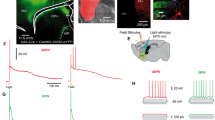Abstract
Synaptic responses (postsynaptic potentials and action potentials) were evoked in mesencephalic decerebellated cats by stimulating pontine bulbar locomotor and inhibitory sites (LS and IS, respectively) with a current of not more than 20 µA in "medial" and "lateral" neurons of the medulla. Some neurons even produced a response to presentation of single (actually low — 2–5 Hz — frequency) stimuli. The remaining cells responded to stimulation at a steady rate of 30–60 Hz only. Both groups of medial neurons were more receptive to input from LS. Lateral neurons responding to even single stimuli reacted more commonly to input from LS and those responding to steady stimulation only to input from IS. Many neurons with background activity (whether lateral or medial) produced no stimulus-bound response, but rhythmic stimulation either intensified or inhibited such activity. This response occurs most commonly with LS stimulation. Partial redistribution of target neurons in step with increasing rate of presynaptic input may play a major part in control of motor activity.
Similar content being viewed by others
Literature cited
K. V. Baev, V. K. Berezovskii, and V. B. Esipenko, "Research into the structural organization and connections between the locomotor strip of the feline medulla," Neirofiziologiya,19, No. 3, 308–315 (1987).
A. Brodal, Brain Stem Reticular Formation [in Russian], Medgiz, Moscow (1960).
I. M. Gel'fand, V. S. Gurfunkel', M. L. Tsetlin, and M. L. Shik, "Aspects of movement," in: Modeling Structuro-Functional Arrangement of Some Biological Systems [in Russian], Nauka, Moscow (1966), pp. 264–276.
G. P. Zhukova and T. A. Leontovich, "Neuronal structure and topography of the reticular formation in predators," Zh. Vyssh. Nerv. Deyat.,14, No. 1, 122–147 (1964).
Sh. Mori, V. A. Selionov, and M. L. Shik, "Response to stimulating locomotor and inhibitory brain stem sites in bulbar neurons in cats," Neirofiziologiya,18, No. 4, 525–533 (1986).
G. N. Orlovskii, "Operation of reticulo-spinal neurons during locomotion," Biofizika,15, No. 4, 728–737 (1970).
V. A. Selionov and M. L. Shik, "Frequency potentiation of synaptic response in the medial bulbar tegmentum to microstimulation of an inhibitory pontine site," Neirofiziologiya,20, No. 2, 172–180 (1988).
V. A. Selionov and M. L. Shik, "Synaptic response in bulbar neurons to stimulation of locomotor and inhibitory brain stem sites," in: The Cerebellum and Brain Stem Structures [in Russian], Pub. Akad. Nauk Armenian SSR (1988).
A. L. Berman, The Brain Stem of the Cat: A Cytoarchitectonic Atlas with Stereotaxic Coordinates, University of Wisconsin Press, Madison (1968).
A. R. Blight, "Axonal physiology of chronic spinal cord injury in the cat: Intracellular recording in vitro," Neuroscience,10, No. 4, 1471–1486 (1983).
J. Buttner-Ennever and G. Holstege, "Anatomy of premotor centers in the reticular formation controlling oculomotor, skeletomotor and autonomic motor systems," Prog. Brain Res.,64, 89–98 (1986).
T. Drew, R. Dubuc, and S. Rossignol, "Discharge patterns of reticulospinal and other reticular neurons in chronic unrestrained cats walking on treadmill," J. Neurophysiol.,55, No. 2, 375–401 (1986).
E. Garcia-Rill and R. D. Skinner, "The mesencephalic locomotor region. II. Projections to reticulospinal neurons," Brain Res.,411, No. 1, 13–20 (1987).
E. Garcia-Rill and R. D. Skinner, "Modulation of rhythmic function in the posterior midbrain," Neuroscience,27, No. 2, 639–654 (1988).
C. F. Martin, T. Cabana, A. O. Humbertson, et al., "Spinal projections from the medullary reticular formation of the North American opossum: Evidence for connectional heterogeneity," J. Comp. Neurol.,196, No. 4, 663–677 (1981).
S. J. Shefchyk and L. M. Jordan, "Excitatory and inhibitory postsynaptic potentials in alpha-motoneurones produced during fictive locomotion by stimulation of the mesencephalic locomotor region," J. Neurophysiol.,53, No. 6, 1345–1355 (1985).
M. Shimamura, J. Kogure, and S.-I. Wada, "Reticular neuron activities associated with locomotion in thalamic cats," Brain Res.,231, No. 1, 51–62 (1982).
K. Takakusaki, Y. Ohta, and S. Mori, "Single medullary reticulospinal neurons exert postsynaptic inhibitory effects via inhibitory interneurons upon alpha-motoneurons innervating cat hindlimb muscles," Exp. Brain Res.,74, No. 1, 11–23 (1989).
A. L. Towe and G. W. Harding, "Extracellular microelectrode sampling bias," Exp. Neurol.,29, No. 2, 366–381 (1970).
F. Valverde, "A new type of cell in the lateral reticular formation of the brain stem," J. Comp. Neurol.,117, No. 2, 189–195 (1961).
Additional information
Institute for Research into Information Transmission, Academy of Sciences of the USSR, Moscow. Translated from Neirofiziologiya, Vol. 22, No. 2, pp. 257–266, March–April, 1990.
Rights and permissions
About this article
Cite this article
Selionov, V.A., Shik, M.L. Two patterns of bulbar neuronal response to microstimulation of locomotor and inhibitory brain stem sites. Neurophysiology 22, 205–212 (1990). https://doi.org/10.1007/BF01052172
Received:
Issue Date:
DOI: https://doi.org/10.1007/BF01052172



